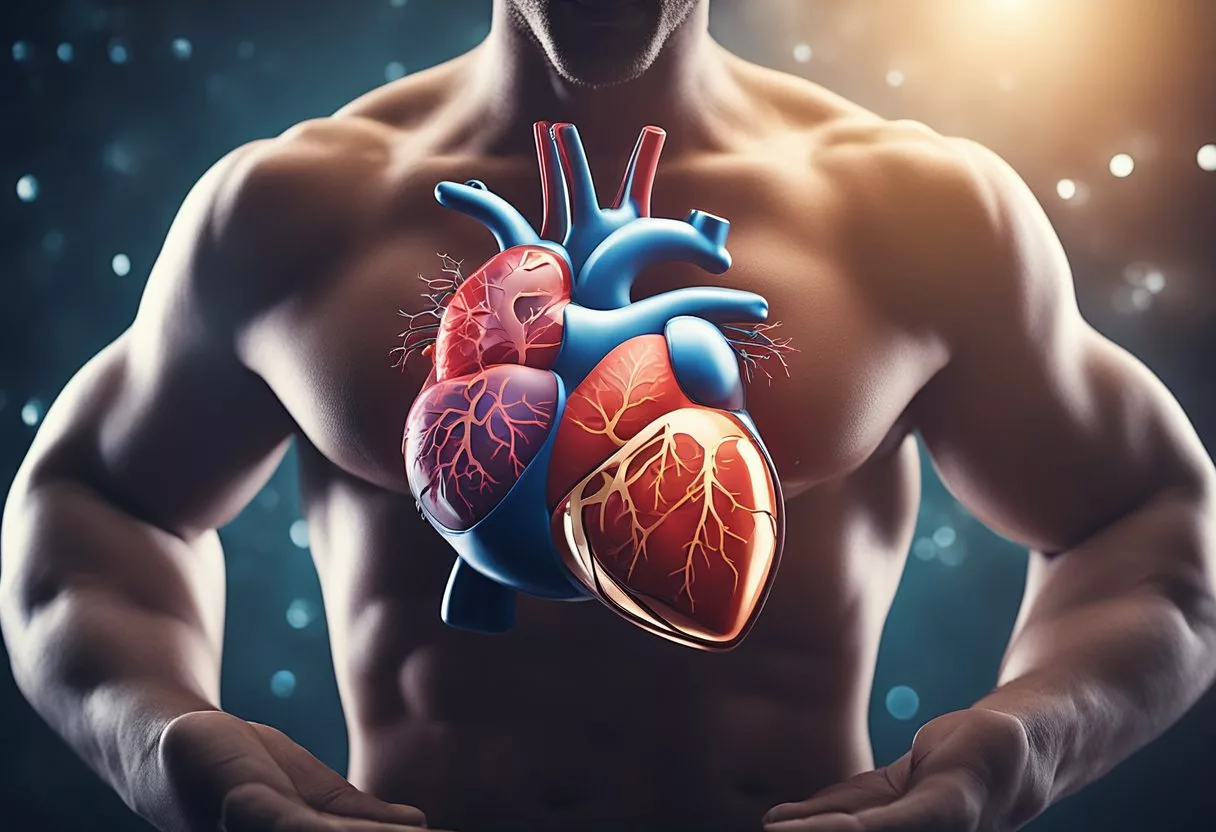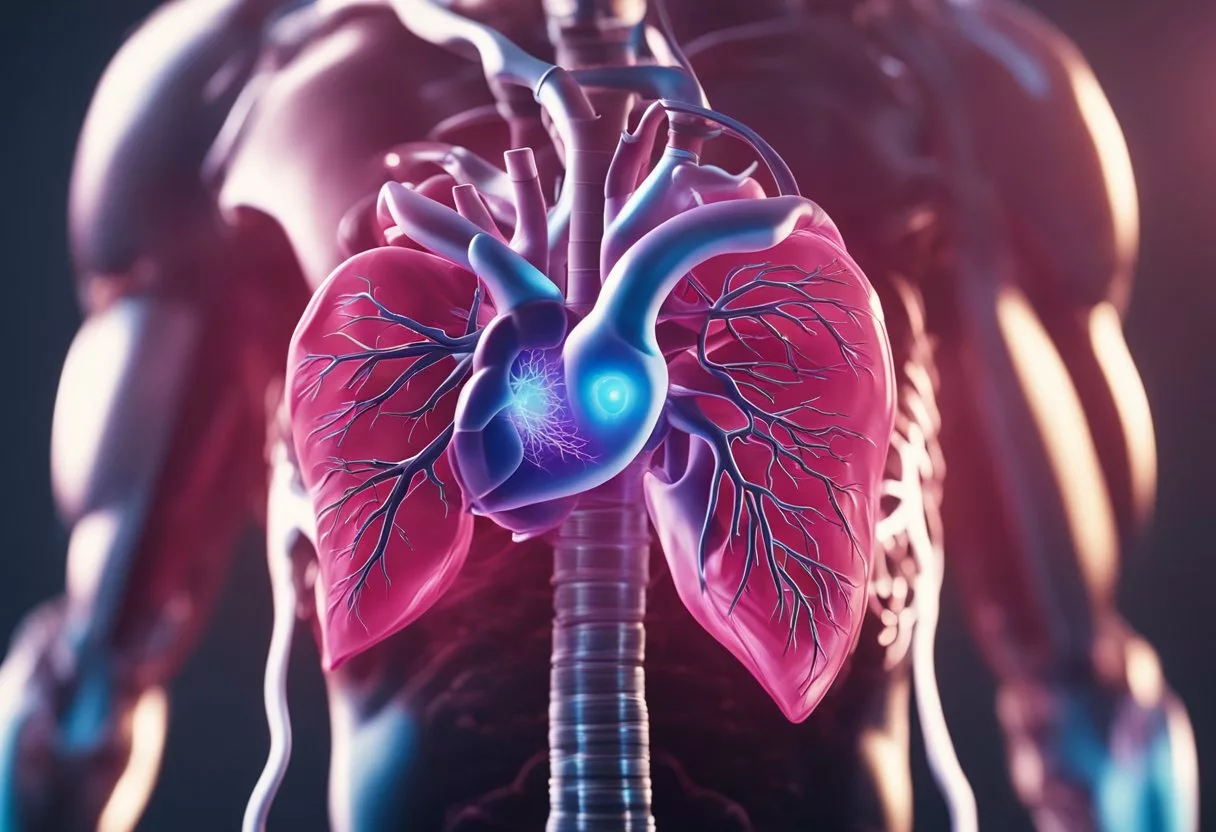Regular exercise is an essential part of a healthy lifestyle. Cardio, also known as cardiovascular exercise, is a type of physical activity that increases your heart rate and breathing rate, and improves the health of your heart and lungs. Many people wonder what would happen if they did cardio every day.

Cardiovascular exercise is known to have numerous health benefits, including improved heart health, better weight management, and increased energy levels. When you do cardio every day, your heart becomes stronger, and your lung capacity increases. This means that your body can deliver more oxygen to your muscles, which helps to improve your endurance and stamina. Additionally, cardio can help to reduce your risk of developing chronic diseases such as heart disease, stroke, and diabetes.
Understanding Cardiovascular Exercise

Defining Cardio
Cardiovascular exercise, also known as aerobic exercise, is any physical activity that increases heart rate and breathing rate to improve the body’s cardiovascular system. This type of exercise involves large muscle groups and is typically performed for an extended period of time, such as 30 minutes or more.
Types of Cardio Exercises
There are many different types of cardio exercises, including running, swimming, cycling, and dancing. These exercises can be performed indoors or outdoors, and can be done alone or in a group setting. The type of cardio exercise that is best for an individual depends on their personal preferences, fitness level, and any physical limitations they may have.
Cardio vs. Strength Training
While cardio exercise is important for overall health and fitness, it is not the only type of exercise that should be incorporated into a workout routine. Strength training, which involves using weights or resistance to build muscle, is also an important component of a well-rounded fitness program. Both cardio and strength training provide unique benefits, and incorporating both types of exercise into a workout routine can help individuals achieve their fitness goals.
In summary, cardio exercise is a key component of a healthy lifestyle, and can help improve the body’s cardiovascular system. By incorporating different types of cardio exercise into a workout routine, individuals can enjoy a variety of benefits, including improved heart health, increased endurance, and reduced risk of chronic disease.
Immediate Effects of Daily Cardio

Cardiovascular exercise, or cardio, is any activity that elevates the heart rate and increases blood flow. Doing cardio every day can have immediate effects on the body. Here are some of the immediate effects of daily cardio:
Boost in Heart Rate
When a person engages in cardiovascular exercise, the heart rate increases to meet the demand for more oxygen and energy. The heart is a muscle, and like any muscle, it becomes stronger with use. Daily cardio can help strengthen the heart muscle, making it more efficient at pumping blood throughout the body.
Increase in Blood Flow
Daily cardio can also increase blood flow to the muscles, which can help improve their function. Improved blood flow can also help deliver oxygen and nutrients to the cells, which can help them function more efficiently.
Oxygen Uptake and Energy Production
During cardio, the body uses oxygen to produce energy. Daily cardio can help improve the body’s ability to take in and use oxygen, which can help improve energy production. This can lead to an increase in overall energy levels throughout the day.
In summary, daily cardio has immediate effects on the body, including a boost in heart rate, increased blood flow, and improved oxygen uptake and energy production. These effects can lead to improved overall health and energy levels.
Short-Term Health Impacts

Regular cardio exercise has numerous short-term health benefits that can be felt almost immediately. Here are some of the most notable benefits:
Weight Loss and Fat Reduction
One of the most significant short-term benefits of cardio exercise is weight loss and fat reduction. According to a study by the American Council on Exercise, a 150-pound person can burn up to 400 calories in just 30 minutes of moderate-intensity cardio exercise. This calorie burn can lead to weight loss and fat reduction, which can improve overall health and reduce the risk of chronic diseases such as diabetes and heart disease.
Improved Mood and Stress Relief
Cardio exercise has also been shown to improve mood and reduce stress levels. This is due to the release of endorphins, which are chemicals in the brain that act as natural painkillers and mood elevators. Endorphins are released during exercise, which can lead to feelings of happiness and well-being. Additionally, cardio exercise can help reduce cortisol levels in the body, which is a hormone that is released in response to stress.
Enhanced Sleep Quality
Another short-term benefit of cardio exercise is enhanced sleep quality. Studies have shown that regular exercise can improve the quality of sleep, making it easier to fall asleep and stay asleep throughout the night. This is due to the fact that exercise can help regulate the body’s circadian rhythm, which is the internal clock that controls sleep and wake cycles.
In summary, regular cardio exercise has numerous short-term health benefits, including weight loss and fat reduction, improved mood and stress relief, and enhanced sleep quality. These benefits can be felt almost immediately and can lead to improved overall health and well-being.
Long-Term Health Benefits

Regular cardio exercise can have numerous long-term health benefits. Not only does it help with weight management, but it can also improve heart and lung health, muscle and joint strength, blood pressure and cholesterol management, and reduce the risk of chronic diseases.
Heart and Lung Health
Cardio exercise helps to strengthen the heart and lungs, which can lead to a reduced risk of heart disease and stroke. According to a study by the American Heart Association, regular cardio exercise can also help to lower blood pressure and cholesterol levels, which are both risk factors for heart disease.
Muscle and Joint Strength
Cardio exercise can also help to improve muscle and joint strength. This is especially important for older adults, as it can help to prevent falls and injuries. The increased blood flow and oxygen delivery to the muscles during cardio exercise can also help to improve muscle endurance and reduce fatigue.
Blood Pressure and Cholesterol Management
Cardio exercise has been shown to help regulate blood pressure and cholesterol levels. According to the American Heart Association, regular cardio exercise can help to lower blood pressure and improve cholesterol levels, which can reduce the risk of heart disease and stroke.
Reduced Risk of Chronic Diseases
Regular cardio exercise has been shown to reduce the risk of chronic diseases such as diabetes, heart disease, and cancer. According to the American Cancer Society, regular exercise can help to reduce the risk of certain types of cancer, such as breast and colon cancer.
Overall, regular cardio exercise can have numerous long-term health benefits for individuals of all ages. By improving heart and lung health, muscle and joint strength, and regulating blood pressure and cholesterol levels, cardio exercise can help to reduce the risk of chronic diseases and improve overall quality of life.
Mental and Cognitive Effects

Mental Health and Emotional Well-Being
Cardiovascular exercise has been shown to have a positive impact on mental health and emotional well-being. According to a study published in the Journal of Psychiatric Research, regular exercise can help reduce symptoms of depression and anxiety. The study found that individuals who engaged in regular exercise had lower levels of depression and anxiety compared to those who did not exercise regularly.
In addition, cardiovascular exercise has been shown to reduce stress levels. When you engage in cardiovascular exercise, your body releases endorphins, which are natural mood-boosters. These endorphins can help reduce feelings of stress and anxiety.
Cognitive Function and Memory
Cardiovascular exercise has also been shown to have a positive impact on cognitive function and memory. According to a study published in the Journal of Alzheimer’s Disease, regular exercise can help reduce the risk of developing dementia and Alzheimer’s disease. The study found that individuals who engaged in regular exercise had better cognitive function and memory compared to those who did not exercise regularly.
The reason for this is that cardiovascular exercise increases blood flow to the brain, which can help improve cognitive function and memory. In addition, regular exercise can help stimulate the growth of new brain cells, which can also improve cognitive function and memory.
It’s important to note that while cardiovascular exercise can have a positive impact on mental health and cognitive function, it should not be used as a substitute for professional treatment for mental health conditions. Individuals who are experiencing symptoms of depression, anxiety, or other mental health conditions should seek professional help from a qualified healthcare provider.
Exercise Intensity and Recovery

Understanding Exercise Intensity
Exercise intensity refers to how hard the body is working during physical activity. It is typically measured in terms of heart rate, which is an indicator of how much oxygen the body is using. The higher the heart rate, the more intense the exercise is. There are different levels of exercise intensity, including low, moderate, and high intensity.
Moderate-intensity exercise, such as brisk walking or cycling, is recommended for general health benefits, and can be done for 30 minutes a day, five days a week 1. Vigorous-intensity exercise, such as running or swimming, is recommended for those who want to see greater improvements in their fitness levels, and can be done for 20 minutes a day, three days a week 1.
Importance of Recovery and Rest Days
Recovery and rest days are an important part of any exercise routine, especially when it comes to high-intensity exercise. During exercise, the body undergoes stress and damage to the muscles and tissues. Recovery periods allow the body to repair and rebuild these tissues, which can lead to improved performance and reduced risk of injury.
Rest days are also important to prevent overtraining and burnout. Overtraining can lead to decreased performance, increased risk of injury, and even illness 2. It is recommended to take at least one rest day per week, and to listen to the body’s signals for when it needs additional rest.
In conclusion, understanding exercise intensity and the importance of recovery and rest days is crucial for anyone looking to improve their fitness levels through cardio exercise. By incorporating moderate to vigorous-intensity exercise into a routine, and allowing for adequate rest and recovery, individuals can see significant improvements in their overall health and fitness.
References:
Injury Prevention and Safety
Common Cardio-Related Injuries
While cardio exercise has numerous benefits, it can also lead to injuries if not done properly. Some of the most common cardio-related injuries include sprains, strains, and overuse injuries such as tendinitis. These injuries can occur due to various factors, including improper form, lack of warm-up, and overtraining.
One of the most common injuries associated with cardio exercise is a sprained ankle, which can occur when the foot turns inward or outward while running or jumping. To prevent ankle sprains, it is important to wear proper shoes that provide adequate support and cushioning. It is also essential to warm up properly and stretch the ankles before exercising.
Another common injury is tendinitis, which is an inflammation of the tendons that can occur in various parts of the body, such as the knees, shoulders, and elbows. Tendinitis is typically caused by overuse and can be prevented by gradually increasing the intensity and duration of cardio exercise and by using proper form.
Safe Practices for Everyday Cardio
To prevent injuries while doing cardio exercise, it is important to follow some basic safety practices, such as warming up properly, using proper form, and stretching after exercise. A proper warm-up should include 5-10 minutes of light cardio exercise, such as walking or jogging, to increase blood flow to the muscles and prepare them for more intense activity.
Using proper form during cardio exercise is also crucial for preventing injuries. For example, when running, it is important to keep the back straight, land on the midfoot, and avoid overstriding. When cycling, it is important to adjust the bike to the proper height and position and to maintain a steady cadence.
Stretching after exercise can also help prevent injuries by improving flexibility and reducing muscle soreness. It is recommended to stretch each muscle group for at least 30 seconds and to hold each stretch without bouncing.
In conclusion, while cardio exercise has numerous health benefits, it is important to take proper precautions to prevent injuries. By following safe practices, such as warming up properly, using proper form, and stretching after exercise, individuals can minimize their risk of injury and enjoy the many benefits of cardio exercise.
Nutrition and Hydration

Dietary Considerations for Cardio Enthusiasts
A well-balanced diet is essential for anyone who exercises regularly, especially those who engage in daily cardio workouts. A diet that includes a variety of nutrient-dense foods such as fruits, vegetables, whole grains, and lean proteins can provide the body with the necessary energy and nutrients to fuel exercise and promote recovery.
Carbohydrates are the primary fuel source for the body during exercise, and they should make up a significant portion of a cardio enthusiast’s diet. Complex carbohydrates such as whole grains, fruits, and vegetables provide sustained energy and help regulate blood sugar levels. On the other hand, simple carbohydrates such as candy, soda, and other sugary snacks can cause a rapid spike in blood sugar levels and lead to a subsequent crash in energy levels.
In addition to carbohydrates, protein is also essential for muscle repair and recovery. Cardio enthusiasts should aim to consume lean sources of protein such as chicken, fish, and beans to support muscle growth and repair.
Hydration and Performance
Proper hydration is crucial for optimal performance during exercise. Cardio enthusiasts should aim to drink water before, during, and after exercise to maintain proper hydration levels. Dehydration can lead to fatigue, decreased endurance, and impaired cognitive function.
The amount of water needed during exercise varies depending on several factors, including the intensity and duration of the workout and the individual’s body weight. As a general rule, athletes should aim to consume 17-20 ounces of water 2-3 hours before exercise and 7-10 ounces of water every 10-20 minutes during exercise.
In addition to water, sports drinks can be beneficial for athletes who engage in high-intensity workouts lasting longer than 60 minutes. Sports drinks contain electrolytes such as sodium and potassium, which can help replace the electrolytes lost through sweat and improve hydration levels. However, sports drinks are often high in sugar and calories, so they should be consumed in moderation.
Overall, cardio enthusiasts should aim to maintain a well-balanced diet and proper hydration levels to support optimal performance during exercise.
Tailoring Cardio to Individual Needs

Cardiovascular exercise is beneficial for people of all ages and fitness levels. However, the type, duration, and intensity of cardio workouts should be tailored to an individual’s needs and goals. Here are some considerations for different groups of people:
Cardio for Different Age Groups
Age is an important factor to consider when designing a cardio workout plan. Younger people may be able to handle higher intensity workouts, while older people may need to focus on low-impact activities to avoid joint pain and injury.
For children and teenagers, activities such as running, swimming, and playing sports can help improve cardiovascular health and overall fitness. Older adults may benefit from activities such as brisk walking, cycling, or water aerobics.
Adapting Cardio for Health Conditions
Individuals with health conditions such as type 2 diabetes and asthma can still benefit from cardio workouts, but may need to take certain precautions. For example, people with diabetes should monitor their blood sugar levels before and after workouts, and may need to adjust their medication or food intake accordingly. Those with asthma should choose activities that are less likely to trigger symptoms, such as swimming or walking.
Progression and Variation in Workouts
It’s important to gradually increase the intensity and duration of cardio workouts to avoid injury and promote continued progress. Beginners should start with low-impact activities such as walking or cycling, and gradually work up to more intense activities such as running or high-intensity interval training (HIIT).
Variation in workouts can also help prevent boredom and plateauing. Mixing up activities such as swimming, cycling, and running, or changing the duration and intensity of workouts, can help keep things interesting and challenging.
In conclusion, tailoring cardio workouts to individual needs is crucial for maximizing the benefits of cardiovascular exercise. By taking into account factors such as age, health conditions, and progression, individuals can design a workout plan that is safe, effective, and enjoyable.
Lifestyle Integration
Regular exercise is essential for maintaining good health, and incorporating cardio into daily life can be a great way to achieve this. Here are a few tips on how to integrate cardio into your daily routine:
Incorporating Cardio into Daily Life
- Walking: Walking is a low-impact form of cardio that can be easily integrated into daily life. One can take the stairs instead of the elevator, walk to work, or take a brisk walk during lunch breaks.
- Gardening: Gardening can be a fun way to get some exercise while also enjoying the outdoors. It can involve activities like digging, planting, and weeding, which can be a great form of low-intensity cardio.
- Dancing: Dancing is a fun and enjoyable way to get some cardio exercise. One can take a dance class or simply dance around the house while doing chores.
- Sports: Sports like soccer and tennis can be a great way to get some cardio exercise while also having fun. One can join a local team or play with friends.
Balancing Cardio with Other Activities
It is important to balance cardio with other activities to avoid overdoing it. Here are a few tips on how to balance cardio with other activities:
- Strength Training: Incorporating strength training into a workout routine can help balance cardio and build muscle. It can involve activities like weightlifting, push-ups, and squats.
- Rest Days: It is important to take rest days to allow the body to recover and avoid overtraining. One can use rest days to engage in low-intensity activities like yoga or stretching.
- Variety: It is important to vary the types of cardio activities to avoid boredom and prevent overuse injuries. One can try different activities like swimming, cycling, or hiking to keep things interesting.
In conclusion, integrating cardio into daily life can be an easy and fun way to achieve regular exercise. By balancing cardio with other activities and varying the types of activities, one can maintain good health and avoid overuse injuries.